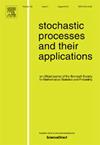New continuity results for a class of time fractional stochastic heat equations in bounded and unbounded domains
IF 1.2
2区 数学
Q3 STATISTICS & PROBABILITY
引用次数: 0
Abstract
In this paper, we consider a class of time fractional stochastic heat type equation where is the Caputo fractional derivative, is a Lipschitz continuous function, and is space–time white noise. These equations have significant applications in modeling temperature in thermal materials. Our main purpose in this paper is to study the continuity of solutions of fractional order Equation (1) with respect to . Two interesting questions for our problem are stated as follows. Let and be the solution of Equation (1) for and , respectively. The first question is that : Does in an appropriate sense as ? The second question is that: Does in an appropriate sense as ? We will give affirmative answers to both of these questions. Furthermore, under some suitable assumptions on the initial datum, we provide the convergence rate estimates between and , as well as and .
一类时间分数型随机热方程在有界和无界区域的新的连续性结果
本文考虑一类时间分数型随机热型方程∂tαuα=∂xxuα+It1−α[λσ(uα)Ẇ(t,x)],其中∂tα,0<α<;1为Caputo分数阶导数,σ:R→R为Lipschitz连续函数,Ẇ为时空白噪声。这些方程在热材料的温度模拟中有重要的应用。本文的主要目的是研究分数阶方程(1)解关于α的连续性。关于我们的问题,有两个有趣的问题陈述如下。设uα和u分别为方程(1)对0<;α<;1和α=1的解。第一个问题是:uα ‘→uα是否与α→α ’具有适当的意义?第二个问题是:在适当的意义上,uα→u是否等于α→1−?我们将对这两个问题给予肯定的答复。在适当的初始假设条件下,给出了uα与uα′、uα与u之间的收敛速率估计。
本文章由计算机程序翻译,如有差异,请以英文原文为准。
求助全文
约1分钟内获得全文
求助全文
来源期刊

Stochastic Processes and their Applications
数学-统计学与概率论
CiteScore
2.90
自引率
7.10%
发文量
180
审稿时长
23.6 weeks
期刊介绍:
Stochastic Processes and their Applications publishes papers on the theory and applications of stochastic processes. It is concerned with concepts and techniques, and is oriented towards a broad spectrum of mathematical, scientific and engineering interests.
Characterization, structural properties, inference and control of stochastic processes are covered. The journal is exacting and scholarly in its standards. Every effort is made to promote innovation, vitality, and communication between disciplines. All papers are refereed.
 求助内容:
求助内容: 应助结果提醒方式:
应助结果提醒方式:


